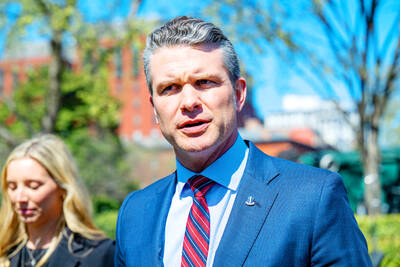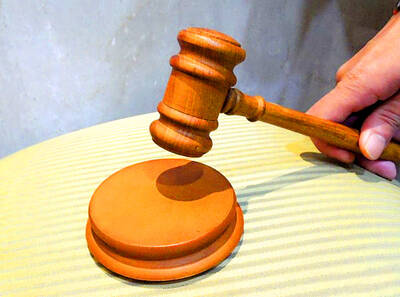The addition of US-made M1A2T Abrams tanks would enhance Taiwan’s military capabilities in anti-landing operations, Taiwanese defense experts said following the arrival of the first batch of the advanced armored vehicles in the country on Sunday.
The 38 M1A2T tanks, a variant of the M1 Abrams, were delivered to the Port of Taipei on Sunday. Before this, deliveries of the last type of tank Taiwan received from the US, the M60A3, began in 1994.
The delivery marks the arrival of the first batch of 108 M1A2T tanks and related equipment, which the US government approved for sale to Taiwan in 2019.

Photo: EPA-EFE
They were transported to the Hsinchu-based Armor Training Command yesterday.
The army previously said that 10 of the tanks would remain at its Armor Training Command and the rest would be deployed to two armored brigades in New Taipei City’s Linkou District (林口) and Hsinchu County’s Hukou Township (湖口) to help defend northern Taiwan.
Chieh Chung (揭仲), a research fellow at the Association of Strategic Foresight, said Taiwan’s army has relied on aging US-made M60A3s and indigenously developed CM11 tanks.
These would be no match for the Chinese People’s Liberation Army’s (PLA) advanced Type 05 amphibious fighting vehicles, he added.
Taiwan’s defense would be at a disadvantage without access to the latest generation of advanced tanks, Chieh said.
Lin Ying-yu (林穎佑), an assistant professor at Tamkang University’s Graduate Institute of International Affairs and Strategic Studies, said Taiwan’s existing tanks — M60A3s and CM11s — have been in service for three decades and would likely be unable to withstand PLA anti-armor firepower.
He said the addition of M1A2Ts would boost Taiwan’s defense.
Su Tzu-yun (蘇紫雲), a research fellow at the military-funded Institute for National Defense and Security Research (INDSR), said that in the event of a PLA landing operation, Taiwan’s first line of defense would be anti-ship missiles, followed by domestic and US-made mobile artillery rocket systems, such as the Thunderbolt-2000 RT/LT-2000, M109 self-propelled howitzer and M142 High Mobility Artillery Rocket Systems.
Combat helicopters such as the AH-64E Apache attack helicopters stand at the third line of defense and coastal defense missiles serve as the fourth line, he said.
The fifth and final line of defense is comprised of tanks, including M1A2Ts and ground forces, he added.
Huang An-hao (黃恩浩), also a research fellow at INDSR, said M1A2Ts and other kinds of tanks play a crucial role in Taiwan’s joint air-ground operations, and would be deployed alongside mechanized infantry troops and with aviation and special forces.
Huang said the combination of M1A2T tanks on the ground and AH-64E helicopters in the air could double Taiwan’s capacity to eliminate invading forces from its beaches and shores.
The M1A2T tanks are equipped with 120mm smoothbore guns that can penetrate 850mm armor and withstand shells fired from most battle tanks.
Their average speed is also significantly faster than Taiwan’s current tanks. The combat vehicle also has a “hunter-killer capacity,” which means it can engage a target while also tracking another.
The armed forces would receive 42 more M1A2Ts next year and 28 in 2026, the Ministry of National Defense’s delivery schedule showed.

‘DENIAL DEFENSE’: The US would increase its military presence with uncrewed ships, and submarines, while boosting defense in the Indo-Pacific, a Pete Hegseth memo said The US is reorienting its military strategy to focus primarily on deterring a potential Chinese invasion of Taiwan, a memo signed by US Secretary of Defense Pete Hegseth showed. The memo also called on Taiwan to increase its defense spending. The document, known as the “Interim National Defense Strategic Guidance,” was distributed this month and detailed the national defense plans of US President Donald Trump’s administration, an article in the Washington Post said on Saturday. It outlines how the US can prepare for a potential war with China and defend itself from threats in the “near abroad,” including Greenland and the Panama

A wild live dugong was found in Taiwan for the first time in 88 years, after it was accidentally caught by a fisher’s net on Tuesday in Yilan County’s Fenniaolin (粉鳥林). This is the first sighting of the species in Taiwan since 1937, having already been considered “extinct” in the country and considered as “vulnerable” by the International Union for Conservation of Nature. A fisher surnamed Chen (陳) went to Fenniaolin to collect the fish in his netting, but instead caught a 3m long, 500kg dugong. The fisher released the animal back into the wild, not realizing it was an endangered species at

The High Prosecutors’ Office yesterday withdrew an appeal against the acquittal of a former bank manager 22 years after his death, marking Taiwan’s first instance of prosecutors rendering posthumous justice to a wrongfully convicted defendant. Chu Ching-en (諸慶恩) — formerly a manager at the Taipei branch of BNP Paribas — was in 1999 accused by Weng Mao-chung (翁茂鍾), then-president of Chia Her Industrial Co, of forging a request for a fixed deposit of US$10 million by I-Hwa Industrial Co, a subsidiary of Chia Her, which was used as collateral. Chu was ruled not guilty in the first trial, but was found guilty

The Chinese Nationalist Party (KMT) is maintaining close ties with Beijing, the Democratic Progressive Party (DPP) said yesterday, hours after a new round of Chinese military drills in the Taiwan Strait began. Political parties in a democracy have a responsibility to be loyal to the nation and defend its sovereignty, DPP spokesman Justin Wu (吳崢) told a news conference in Taipei. His comments came hours after Beijing announced via Chinese state media that the Chinese People’s Liberation Army’s Eastern Theater Command was holding large-scale drills simulating a multi-pronged attack on Taiwan. Contrary to the KMT’s claims that it is staunchly anti-communist, KMT Deputy